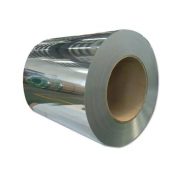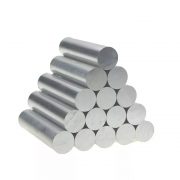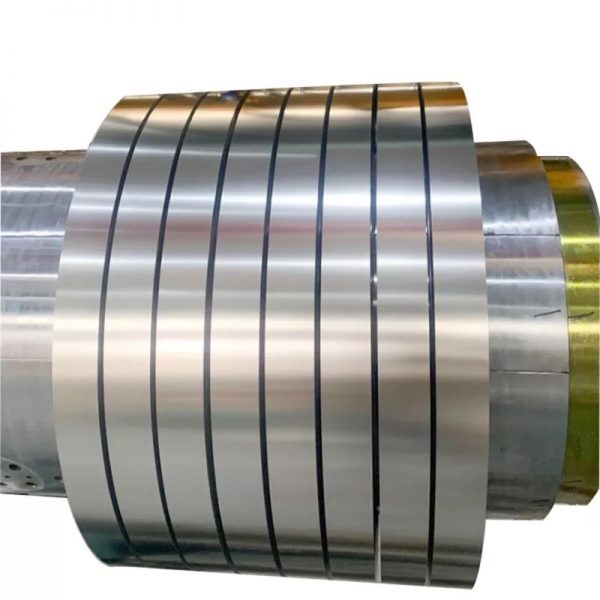
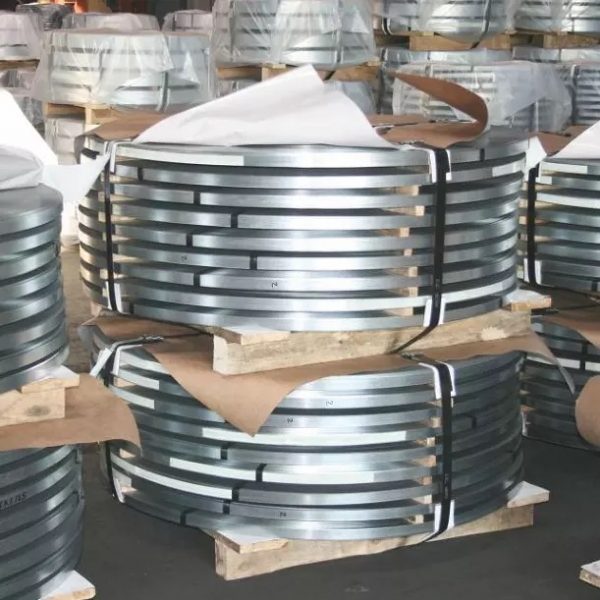
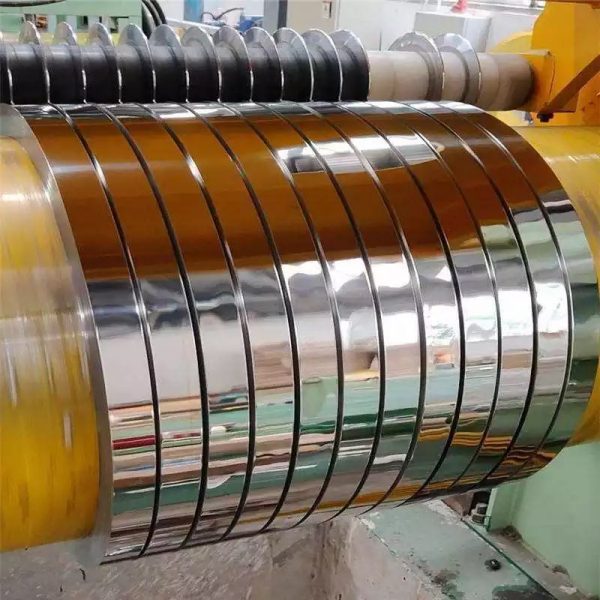

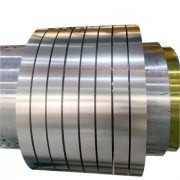
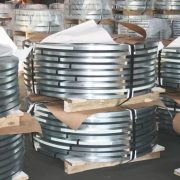
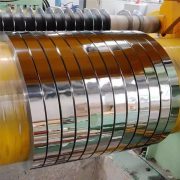

Nastri in acciaio inossidabile
Acciaio inossidabile è il nome dato a un gruppo di acciai resistenti alla corrosione e alle alte temperature. La loro notevole resistenza alla corrosione è dovuta ad un film di ossido ricco di cromo che si forma sulla superficie. Quando l'acciaio al carbonio ordinario è esposto all'acqua piovana, Per esempio, si corrode formando un ossido di ferro marrone, comunemente chiamata ruggine, in superficie. Questo non è protettivo e alla fine l'intero pezzo di acciaio si corroderà e sarà convertito in ruggine. Ma quando abbastanza cromo (più di circa 10%) viene aggiunto all'acciaio ordinario, L'ossido sulla superficie viene trasformato – è molto sottile, Praticamente invisibile e protettivo in una vasta gamma di fluidi corrosivi. Questo è ciò che chiamiamo acciaio inossidabile e ci sono diversi tipi diversi, e molti gradi diversi.
La produzione di acciaio inossidabile di qualità, da calore a calore e di anno in anno, richiede un controllo preciso degli ingredienti delle materie prime e delle pratiche di fusione. Quantità esatte di rottami ed elementi di lega vengono consegnati ai forni fusori dei laminatoi in modo che i calori o i lotti rientrino in intervalli di composizione specificati.. Tali intervalli di composizione includono tipicamente un gruppo di elementi chimici per ciascun tipo di acciaio inossidabile..
- Descrizione
- Types of Stainless Steel Strips
- Inchiesta

|
Nome del prodotto
|
Stainless Steel Strip
|
|
Tecnologia
|
Hot Rolled Industrial Stainless Steel Strip
|
|
Cold Rolled Decorative Stainless Steel Strip
|
|
|
Materiale
|
201,202,301,302,304,304L,310S,316,316L,321,430,430Un,309S,2205,2507,2520,430,410,440,904L etc, Or Customized
|
|
Spessore
|
Laminati a freddo 0.05-3 millimetro; Laminati a caldo 3-10 millimetro
|
|
Lunghezza
|
Customer’s Requirement
|
|
Width
|
10-2000 mm or as request
|
|
Superficie
|
BA/NO.1/NO.3/NO.4/8K/HL/1D
|
|
Standard
|
JIS AISI ASTM GB DIN EN
|
|
Certifications
|
CE, ISO9001
|
|
Imballaggio
|
Water proof and Seaworthy package
|
|
Termini di pagamento
|
L/C/ T/T (30% DEPOSIT) Or Upon negotiation
|
|
Stock
|
Enough Stock
|
|
Grado
|
C
|
Si
|
Mn
|
P
|
S
|
Ni
|
Cr
|
Mo
|
|
201
|
≤0.15
|
≤0.75
|
5.5-7.5
|
≤0.06
|
≤ 0.03
|
3.5-5.5
|
16.0-18.0
|
–
|
|
301
|
≤0.15
|
≤1.0
|
≤2.0
|
≤0.045
|
≤ 0.03
|
6.0-8.0
|
16.0-18.0
|
–
|
|
304
|
≤0.08
|
≤1.0
|
≤2.0
|
≤0.045
|
≤ 0.03
|
8.0-10.5
|
18.0-20.0
|
–
|
|
304L
|
≤0.03
|
≤1.0
|
≤2.0
|
≤0.035
|
≤ 0.03
|
9.0-13.0
|
18.0-20.0
|
–
|
|
316
|
≤0.08
|
≤1.0
|
≤2.0
|
≤0.045
|
≤ 0.03
|
10.0-14.0
|
16.0-18.0
|
2.0-3.0
|
|
316L
|
≤0.03
|
≤1.0
|
≤2.0
|
≤0.045
|
≤ 0.03
|
12.0-15.0
|
16.0-18.0
|
2.0-3.0
|
|
321
|
≤0.08
|
≤1.0
|
≤2.0
|
≤0.035
|
≤ 0.03
|
9.013
|
17.0-1 9.0
|
–
|
|
410
|
≤0.15
|
≤1.0
|
≤1.0
|
≤0.035
|
≤ 0.03
|
–
|
11.5-13.5
|
–
|
|
430
|
≤0.12
|
≤0.75
|
≤1.0
|
≤0,040
|
≤ 0.03
|
≤0.60
|
16.0-18.0
|
–
|


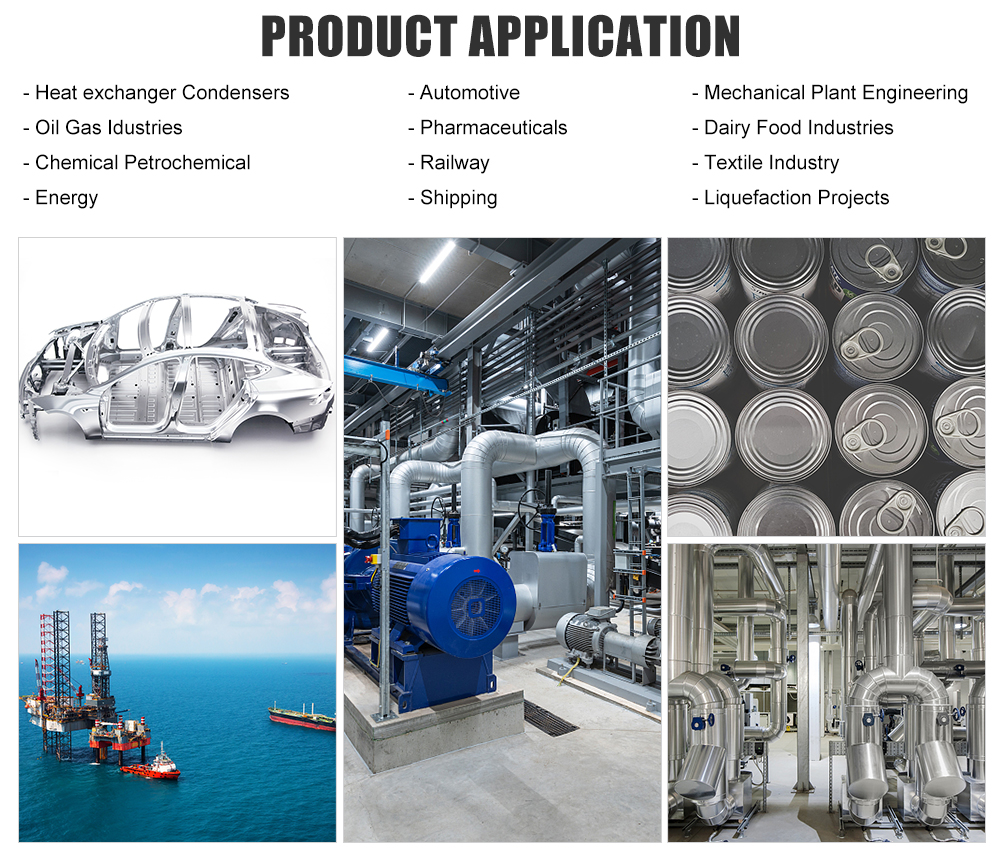
The basic composition of stainless steel is iron (Fe) and chromium (Cr). This is the simplest form of stainless steel, with this family known as the ferritic stainless steels because their crystal structure is called ferrite. (This is also the structure of mild steel.) Le ferritic stainless steels are magnetic like ordinary steel. A commonly used grade is Type 430 (S43000) which is used for automotive trim and inside dishwashers and clothes dryers. They are often the least expensive stainless steels but can be more difficult to form and weld.
If you wish to make carbon steel strong and hard, such as for a drive shaft or wear plate, the mill might increase the carbon content, and then heat treat the steel by quenching and tempering it. The same can be done with stainless steel – if the carbon content of ferritic stainless steels is increased, it produces the family of martensitic stainless steels, used for items such as knives, razor blades and corrosion resistant bearings. Martensitic grades are strong and hard, but are brittle and difficult to form and weld. Digitare 420 (S42000) is a typical example. Like ferritic stainless steels, martensitic stainless steels are magnetic.
The majority of stainless steels contain nickel (Ni), which is added for a number of reasons but particularly to change the crystal structure from ferrite to austenite. Austenitic stainless steels are ductile, tough and, most importantly, easy to form and weld. These steels are not magnetic in the annealed condition. The most common example is Type 304 (S30400) or “18/8” – the most widely used stainless steel in the world. The lower carbon version, Type 304L (S30403) is always preferred in more corrosive environments where welding is involved. There are numerous applications for this grade, ranging from domestic kitchen sinks and building facades to commercial food processing equipment and chemical plant piping.
Molybdenum (Mo) is added to some stainless steels to increase their corrosion resistance, particularly in marine and acidic environments. It increases an alloy’s pitting and crevice corrosion resistance. These corrosion forms are caused by the common and highly aggressive chloride ion (Cl¯), which is present in salts, such as sea salt and table salt. When 2-3% molybdenum is added to Type 304 or 304L, it creates Type 316 (S31600) or 316L (S31603) acciaio inossidabile. They are sometimes referred to as the marine grades of stainless steel, since they are widely used for items such as boat fittings. They are also known as the acid resistant grades, since they have better corrosion resistance in some acids such as sulphuric acid. But their range of applications is wide, from building facades in aggressive atmospheres to piping onboard chemical tankers.
Halfway between the ferritic and austenitic stainless steels is a family called the duplex stainless steels, which are about 50% ferrite and 50% austenite. Because of this duplex structure, they are resistant to stress corrosion cracking which can affect the austenitic stainless steels in hot waters containing chlorides. The most common duplex stainless steel is 2205 (including both S31803 and S32205) and it is used in many applications such as hot water tanks.
Nitrogen (N) is added to some stainless steels, but is very important in duplex grades. It has several beneficial effects. Like nickel, nitrogen promotes austenite (especially important for welding) e, like molybdenum, it improves resistance to pitting and crevice corrosion. It also increases strength. Duplex stainless steels are inherently stronger, but a grade such as 2205, which contains about 0.15% nitrogen, has over twice the yield strength of Type 316L. Thus, 2205 is commonly used in tanks for seagoing chemical tankers where both strength and corrosion resistance are required, and for components such as rods and connectors for glass curtain walls in public buildings where the high strength means that the components can be small and so make the structure seem lighter and more transparent.
There is one more family – the precipitation hardening stainless steels. This is a specialized family which has very high strength achieved by adding elements such as copper, which form very fine particles during heat treatment. They generally have slightly higher corrosion resistance than the martensitic stainless steels but, at best, they have slightly less resistance than Type 304. They are commonly used in the aerospace and defence industries, but also find use in items such as pump shafts. 17-4PH (S17400) is a typical example.
In addition to the common grades mentioned above, there are many more specialized grades of stainless steel for applications which require greater corrosion resistance or higher strength. Three examples are Alloy 904L (N08904), which was originally developed for sulfuric acid service, the super-austenitic grade Alloy 254 (S31254), representing a group of 6% Mo stainless steels; and the grade Alloy 2507 (S32750), representing a group of super-duplex alloys. The last two are ‘seawater resistant’ – they will not suffer pitting or crevice corrosion when immersed in ambient temperature seawater. There are also grades developed for such special needs as improved machinability. Cast versions of most wrought grades are also available, usually slightly modified to improve castability.
Nickel-containing stainless steels and nickel alloys play an important role in providing corrosion resistant, and hence leak resistant, materials of construction for projects internationally. Some of these materials also play a critical role in handling gas production, particularly in liquefied form, thus helping to develop difficult-to-access gas reserves.
Prodotti correlati
-
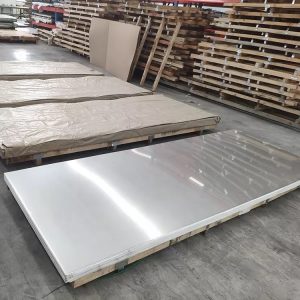
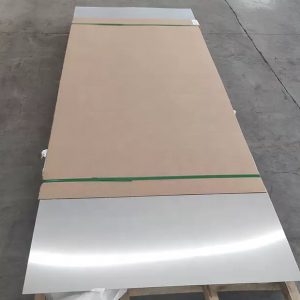 Leggi di piùVista Rapida
Leggi di piùVista RapidaStainless Steel Sheets
Stainless Steel Sheets & Plates are made up of austenitic steel mainly contain chromium and nickel with the addition of rare elements which offer high corrosion resistance, high tensile strength, excellent impact & toughness and high-temperature resistance at cryogenic temperatures. Moreover, these SS Sheets & Plates are highly demanded in various industries like chemical & Trasformazione alimentare, scambiatori di calore, fresco & ambienti marini di acqua salata, automobili e altro ancora.
-
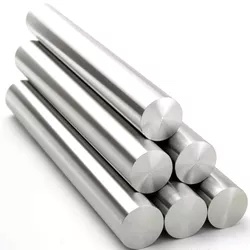
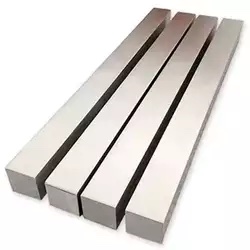 Leggi di piùVista Rapida
Leggi di piùVista RapidaStainless Bar
A stainless steel bar stock is often used for production line machinery or in other industrial settings where durability is required. Stainless steel round bar types can be found in many different shapes such as hexagon, quadrato, or round bars. Stainless bar stock is a material that is non-corrosive, corrosion resistant, and durable. It can be used in a variety of industries such as automotive, aerospaziale, costruzione, and manufacturing.
Stainless steel bar stock is the highest quality type of stainless steel in the industry. They are made with high-quality materials that make them resistant to corrosion and other environmental conditions. The stainless bar stock also has greater tensile strength than other types of stainless steel.
Stainless steel round rod products or round bars are commonly used for manufacturing products like car rims, motorcycle rims, bicycle rims, e altro ancora. These types of bars are typically made by rolling up sheets of stainless steel into long tubes before welding them together at the ends to create round rods or round bars that can be cut into smaller pieces
-
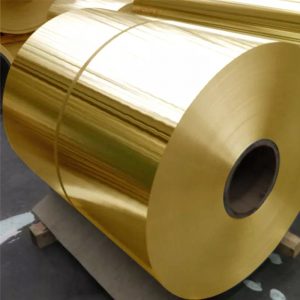
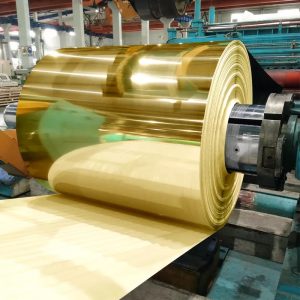 Leggi di piùVista Rapida
Leggi di piùVista RapidaBobina di ottone
La bobina di ottone ha un'eccellente plasticità (Il meglio in ottone) e ad alta resistenza, buona lavorabilità, facile da saldare, molto stabile alla corrosione generale, ma incline alla corrosione; La bobina di ottone è di rame e la lega di zinco prende il nome dal suo colore giallo.
Le proprietà meccaniche e la resistenza all'usura della bobina di ottone sono molto buone, e può essere utilizzato per fabbricare strumenti di precisione, Parti di navi, proiettili di pistole, and so on. L'ottone bussa e suona bene, Quindi strumenti come i piatti, Piatti, Campane, e i numeri sono fatti di ottone. Secondo la composizione chimica, L'ottone è diviso in rame ordinario e ottone speciale.
-
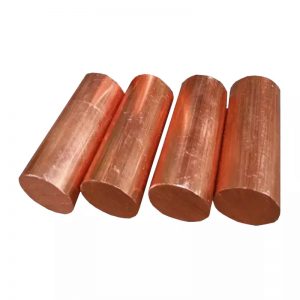
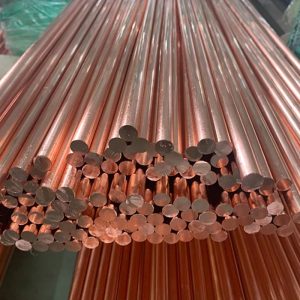 Leggi di piùVista Rapida
Leggi di piùVista RapidaAsta di rame
La barra di rame è un tipo di barra per la lavorazione dei metalli non ferrosi, che ha migliori prestazioni di elaborazione e alta conduttività. È principalmente diviso in tondino di ottone (lega di zinco rame, Più conveniente), asta di rame viola (maggiore contenuto di rame).
L'asta di ottone è un oggetto a forma di asta realizzato in lega di rame e zinco, chiamato per il suo colore giallo. Il punto di fusione dell'ottone, che contiene 56% A 68% rame, è 934 A 967 Gradi. L'ottone ha buone proprietà meccaniche e resistenza all'usura, e può essere utilizzato per fabbricare strumenti di precisione, Parti di navi, bossoli per pistole e così via. Utilizzato nel tubo dell'aria condizionata, tubo frigorifero, tubo dell'olio, tubo di alimentazione dell'acqua e tutti i tipi di materiali meccanici, Anello del cambio sincronizzatore automobilistico, Pompa marina, valvola, parti strutturali, accessori di attrito, and so on.
L'asta di rame viola prende il nome dal suo colore rosso porpora. Ha una buona conduttività elettrica, conduzione del calore, Resistenza alla corrosione e proprietà di lavorazione. Può essere saldato e brasato. Caratteristiche: elevata purezza, struttura fine, basso contenuto di ossigeno. Nessuna porosità, tracoma, sciolto, eccellente conduttività elettrica, Alta precisione della superficie dello stampo per elettroincisione, dopo il processo di trattamento termico, nessuna direzione dell'elettrodo, adatto per il gioco fine, bel gioco, con un buon canale termoelettrico, Lavorabilità, duttilità, resistenza alla corrosione e resistenza agli agenti atmosferici.
-
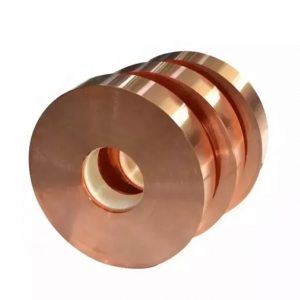
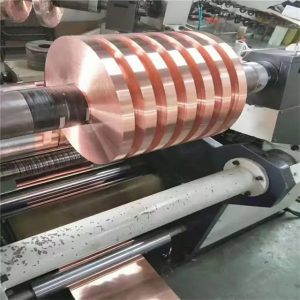 Leggi di piùVista Rapida
Leggi di piùVista RapidaStrisce di rame
Le strisce di rame hanno un'elevata conduttività elettrica e termica, Ecco perché le strisce di rame sono le migliori per l'avvolgimento del trasformatore.
Cosa c'è di più, Le strisce di rame trasferiscono il calore in modo più efficace rispetto ad altre strisce di metallo.
Le strisce di rame sono più malleabili e hanno un'elevata resistenza alla trazione. Resistenza alla corrosione, alto grado di stabilità, e la dissipazione del calore delle strisce di rame è superiore ad altri metalli.
Le strisce di rame sono utilizzate principalmente nei settori elettrico ed elettronico perché il rame non è magnetico e non scintilla. Le strisce di rame sono utilizzate principalmente negli scambiatori di calore, Avvolgimento trasformatori, Condensatori, e parafulmini.
Lo spessore del nastro di rame varia da 0,03 mm a 3,0 mm. Le strisce di rame possono essere prodotte in diverse larghezze e spessori secondo il requisito del cliente.
In caso di domande, Non esitate a contattare sales@grandsteeltube.com
-
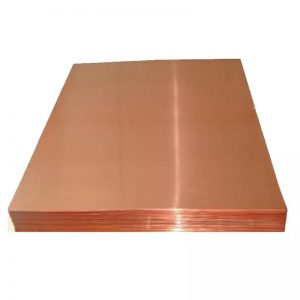
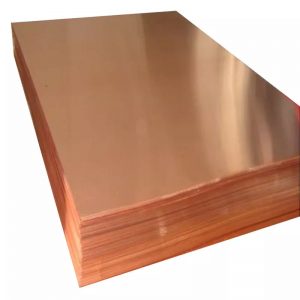 Leggi di piùVista Rapida
Leggi di piùVista RapidaLamiera di rame
La lamiera di rame è una forma di metallo molto lavorabile e malleabile, alta conduttività elettrica e termica, e fornisce un'eccellente resistenza alla corrosione. Un metallo bello e versatile, Il rame è stato utilizzato per migliaia di anni. Storicamente, È servito come scelta preferita nella creazione di strumenti, Vasi, e sculture. Il rame è anche noto per le sue bellissime patine. Quando esposto, Sigillata, ad un ambiente esterno, Il rame inizia ad ossidarsi. Questa esposizione crea bellissime variazioni di colore sotto forma di patina. La colorazione della patina cambierà e svilupperà il carattere nel tempo mentre serve a proteggere il metallo dal deterioramento. Le persone creeranno anche rapidamente una patina con l'uso di miscele chimiche che accelerano il processo e consentono a una patina di svilupparsi senza esposizione all'aperto.. Le lamiere di rame possono anche essere martellate, Lavorata, o goffrato per una maggiore consistenza e un aspetto decorativo o funzionale e sono disponibili in molti spessori da fogli di rame molto sottili a lastre di rame spesse. Inoltre è disponibile in molte leghe che fondono altri metalli con il rame. Al Grand Copper, vendiamo rame puro -C110 · (Altre leghe e tempere disponibili su richiesta). Questa elevata purezza fornisce la qualità premium necessaria per progetti e applicazioni in una vasta gamma di settori e usi. Siamo orgogliosi di fornire il miglior materiale. La nostra alta qualità, Materiale accessibile e amichevole, Un servizio clienti di prim'ordine ci ha reso leader nel settore per oltre un decennio.
-
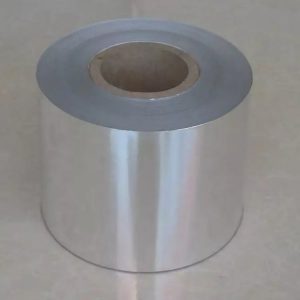
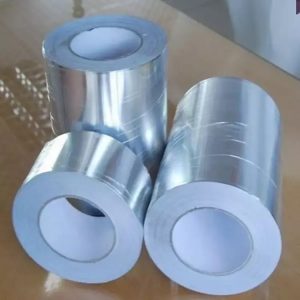 Leggi di piùVista Rapida
Leggi di piùVista RapidaAlluminio
Alluminio è alluminio preparato in sottili foglie di metallo con uno spessore inferiore a 0,2 mm (7.9 Mils); Calibri più sottili fino a 4 I micrometri sono anche comunemente usati. La pellicola domestica standard è in genere 0.016 millimetro (0.63 Mils) spesso, e il foglio domestico pesante è in genere 0.024 millimetro (0.94 Mils). E la pellicola del condizionatore d'aria può essere più sottile di 0,0047 mm, e alcuni fogli alimentari più sottili di 0,002 mm. La pellicola è flessibile e può essere facilmente piegata o avvolta attorno agli oggetti. Le pellicole sottili sono fragili e talvolta sono laminate con altri materiali come plastica o carta per renderle più forti e più utili. È usato industrialmente per una varietà di scopi, compreso l'imballaggio, Isolamento e trasporto. A casa, Le persone usano il foglio di alluminio per la conservazione degli alimenti, per coprire le superfici di cottura e avvolgere i cibi, come le carni, per evitare che perdano umidità durante la cottura.
-
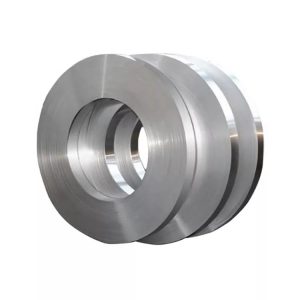
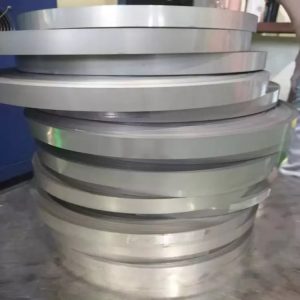 Leggi di piùVista Rapida
Leggi di piùVista RapidaTitanium Strip
Titanium strip is produced from the titanium sheet. Usually cold-rolled the titanium sheet by a small mill with annealing for several times, then slitting shear to titanium strips according to customer requirements. The advanced equipment, rolling process, process control, annealing temperature and return time control ensured its smoothness and finish, effectively improved the quality of our products.
-
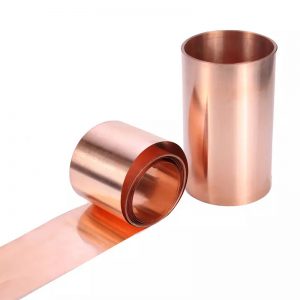
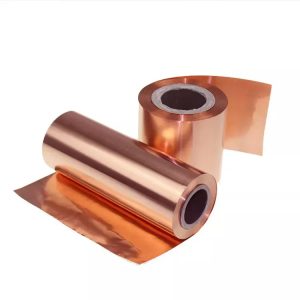 Leggi di piùVista Rapida
Leggi di piùVista RapidaLamina di rame
Il rame è un elemento metallico bruno rossastro con caratteristiche eccezionali come una buona duttilità, duttilità, Calore e conducibilità
Il rame puro è un metallo molto morbido e duttile Per ottenere le prestazioni richieste, possiamo legare con altri metalli L'ottone e il bronzo sono leghe di rame ampiamente utilizzate
Il foglio di rame è realizzato in rame o lega di rame mediante laminazione a caldo e laminazione a freddo Lo spessore del foglio di rame varia da 0,03 mm a 0,2 mm, e la larghezza e la lunghezza possono essere personalizzate in base alle esigenze del cliente
-
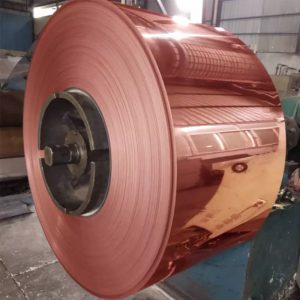
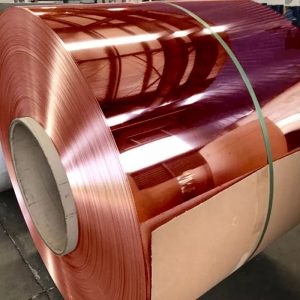 Leggi di piùVista Rapida
Leggi di piùVista RapidaBobine di rame
Può sembrare che una bobina di rame sia un semplice pezzo di filo arrotolato che può essere avvolto e messo in uso. Come per qualsiasi forma di prodotto industriale, Le bobine di rame devono essere progettate con precisione per adattarsi a un'applicazione. Il processo di avvolgimento deve essere completato con precisione per garantire la giusta distanza tra i fili e il diametro dell'apertura.
Ogni prodotto che utilizza bobine di rame richiede che venga effettuato un certo numero di giri per fornire la giusta quantità di resistenza. Calcoli imprecisi possono portare a inefficienza e possibile guasto della bobina o del dispositivo. Per questo motivo, gli ingegneri di Metal Associates garantiscono di aver esaminato attentamente le specifiche di un'applicazione in modo tale che il diametro, spaziatura, spessore del filo, e il numero di giri corrisponde esattamente al design del prodotto in cui verrà utilizzata la bobina di rame.
- DIN2391 Tubo d'acciaio di precisione
- EN10305-1/4 Tubo d'acciaio di precisione
- EN10305-2/3/5/6 Tubi di precisione
- Tubi di precisione serie SAE
- ISO8535-1 tubo di iniezione carburante
- Singolo/Doulbe Wall Bundy Tube
- Caldaia & Tubi in acciaio a pressione
- Tubo d'acciaio levigato / SRB senza saldatura
- Tubi in acciaio inossidabile capillare
- Tubi inossidabili senza saldatura & Cornamusa
- Tubi inossidabili saldati & Cornamusa
- Iniezione & Tubi della linea di controllo
- Tubi in lega di nichel & Cornamusa
- Tubi capillari non ferrosi
- Tubi in alluminio & Cornamusa
- Tubi in ottone & Cornamusa
- Tubi di rame & Cornamusa
- Tubi in titanio & Cornamusa
- Tubo alettato estruso/saldato
- Tubo di precisione non ferroso
- Tubi speciali in acciaio sagomati
- Bobina metallica / lamina / foglio / striscia

